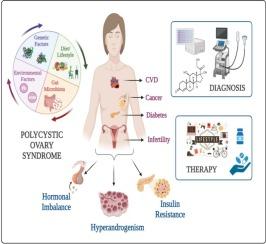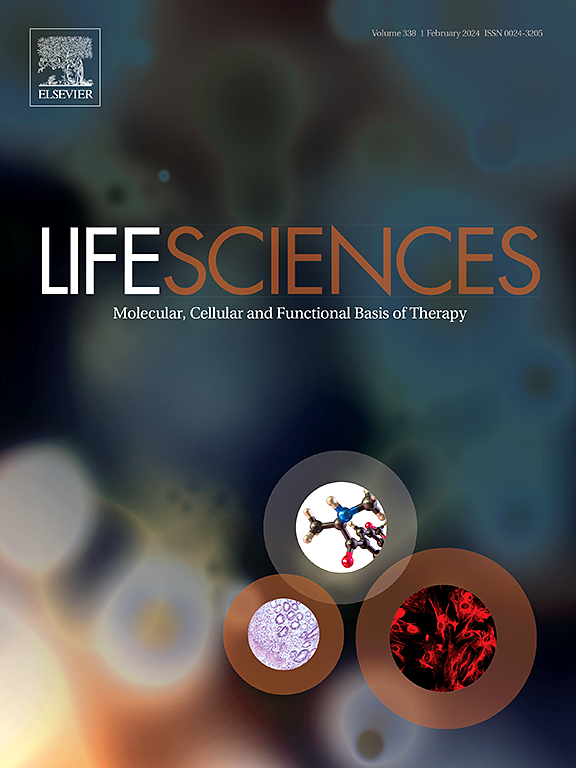多囊卵巢综合征:最新研究和治疗进展。
IF 5.2
2区 医学
Q1 MEDICINE, RESEARCH & EXPERIMENTAL
引用次数: 0
摘要
多囊卵巢综合征的特征通常是卵巢中出现多个小囊肿(充满液体的囊)。多囊卵巢综合征是最重要的内分泌疾病,8%-13% 的妇女一生中都会受到该病的影响。在妇女健康的动态领域中,该综合征是一个普遍问题,表现出一系列症状,包括胰岛素抵抗、多毛、雄激素发育以及由遗传、饮食/生活方式、肠道微生物群失调和环境毒素引起的月经紊乱。卵泡生成障碍、皮质醇代谢异常以及与类固醇生成相关的基因是该病的病理生理学原因。此外,它还与各种并发代谢性和特发性疾病,特别是 2 型糖尿病、心脏病、癌症和不孕症结合在一起。由于高雄激素血症的母体遗传性,该综合征的复杂性在女性从青春期到更年期的生殖系统中代代相传。从鹿特丹标准到代谢组学、三维超声波和辅助生殖技术,诊断标准的进步为该病的治疗铺平了道路。通过改变生活方式和及时用药,可以控制和治疗这种激素紊乱。本综述介绍了上述综合征复杂性的基准,以及为缓解女性从胎儿期到更年期错综复杂的行为变化而正在进行的研究。本文章由计算机程序翻译,如有差异,请以英文原文为准。

Polycystic ovary syndrome: Recent research and therapeutic advancements
Polycystic ovary syndrome is often characterized by the appearance of several tiny cysts (fluid-filled sacs) in the ovaries. It is the most significant endocrinopathy affecting 8–13 % of women during their lifetime. Within the dynamic domain of women's health, this syndrome is a widespread issue that presents with an array of signs, including insulin resistance, hirsutism, androgen development, and menstrual flaws prompted by genetic, diet/lifestyle, gut microbiota dysbiosis, and environmental toxins. Impaired folliculogenesis, aberrant cortisol metabolism, and genes associated with steroidogenesis contribute to the pathophysiology of the disease. Moreover, it combines with various concurrent metabolic and idiopathic conditions specifically type 2 diabetes, heart disease, cancer, and infertility. On persuading the reproductive framework of women from ontogeny to menopause, the complexity of the syndrome hereditates generations due to maternal inheritance of hyperandrogenism. The advancement in diagnostic norms paved the way from the Rotterdam criteria to metabolomics, 3D ultrasound, and assisted reproductive technologies. The management and treatment of this hormonal disorder can be prevailed through lifestyle modifications and prompt medications. This review entails the aforementioned benchmarks of the syndrome's complexity and its ongoing research in alleviating its intricate behavioral changes in women from in-utero to menopause.
求助全文
通过发布文献求助,成功后即可免费获取论文全文。
去求助
来源期刊

Life sciences
医学-药学
CiteScore
12.20
自引率
1.60%
发文量
841
审稿时长
6 months
期刊介绍:
Life Sciences is an international journal publishing articles that emphasize the molecular, cellular, and functional basis of therapy. The journal emphasizes the understanding of mechanism that is relevant to all aspects of human disease and translation to patients. All articles are rigorously reviewed.
The Journal favors publication of full-length papers where modern scientific technologies are used to explain molecular, cellular and physiological mechanisms. Articles that merely report observations are rarely accepted. Recommendations from the Declaration of Helsinki or NIH guidelines for care and use of laboratory animals must be adhered to. Articles should be written at a level accessible to readers who are non-specialists in the topic of the article themselves, but who are interested in the research. The Journal welcomes reviews on topics of wide interest to investigators in the life sciences. We particularly encourage submission of brief, focused reviews containing high-quality artwork and require the use of mechanistic summary diagrams.
 求助内容:
求助内容: 应助结果提醒方式:
应助结果提醒方式:


